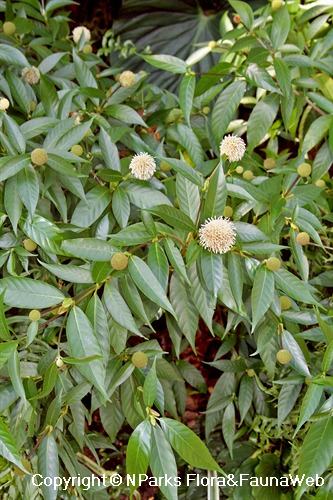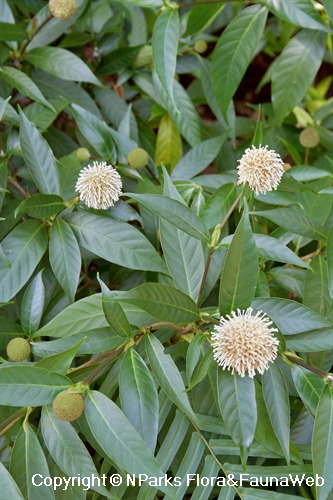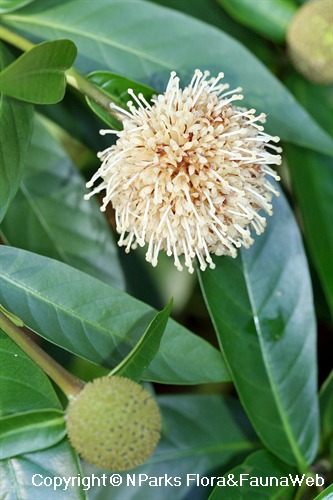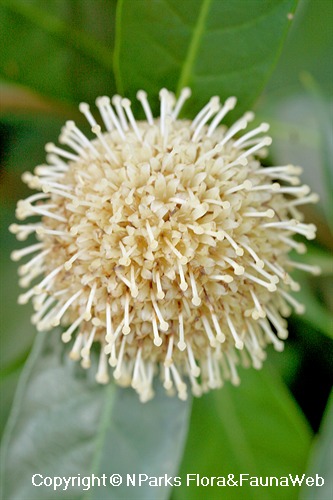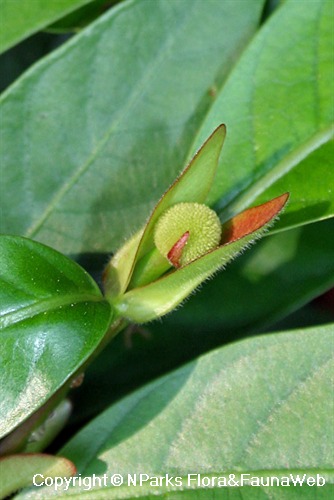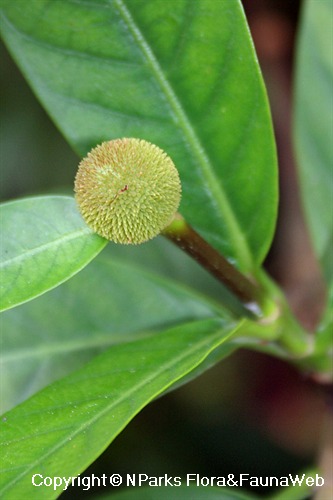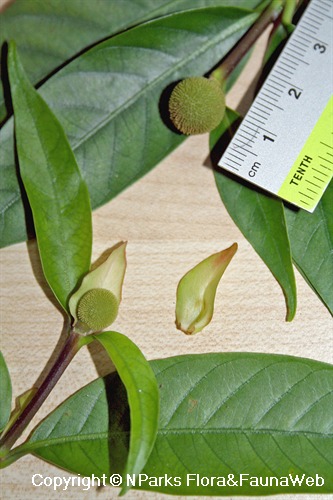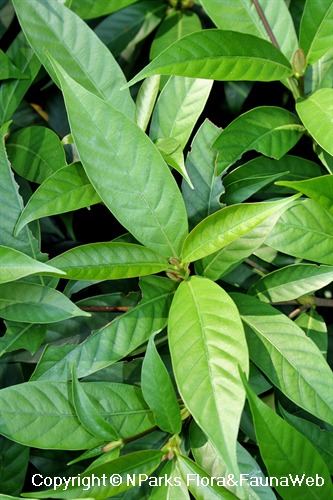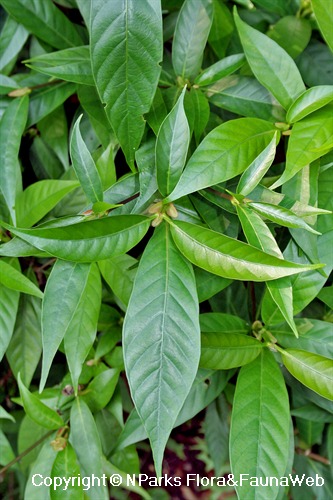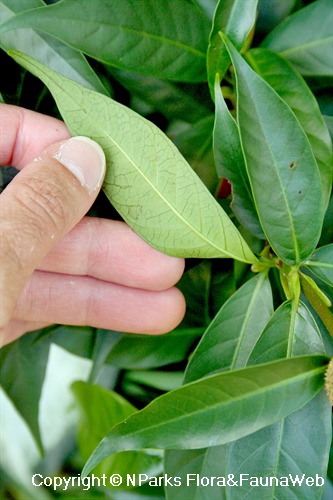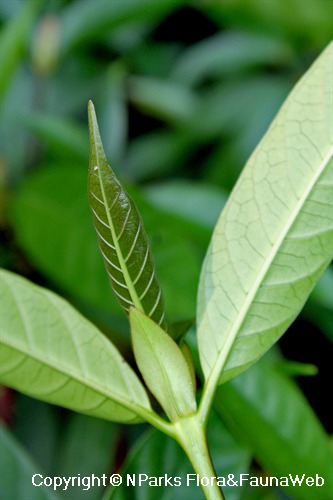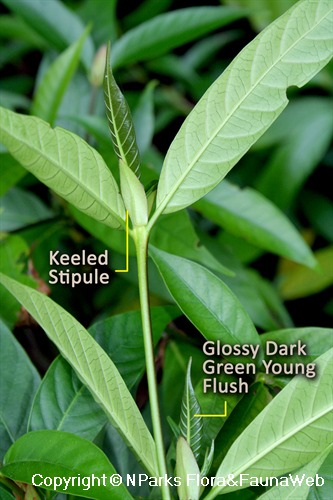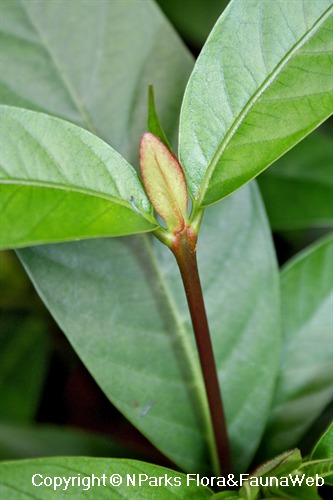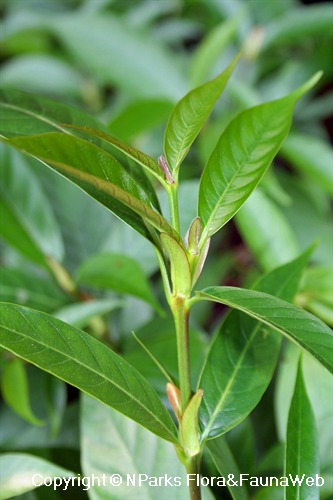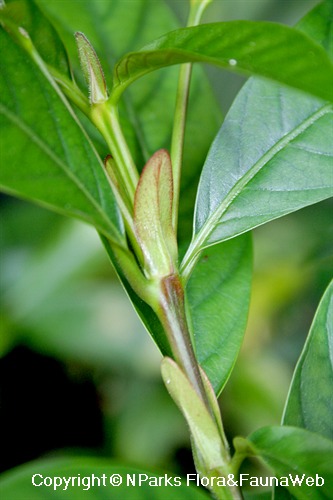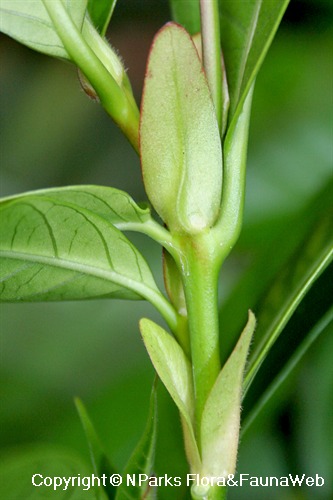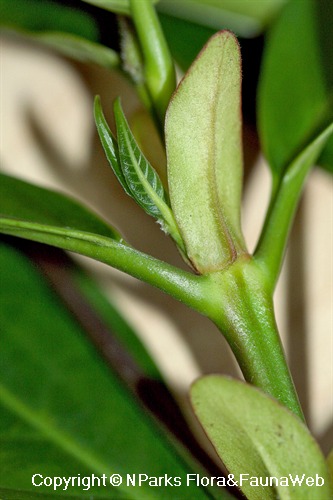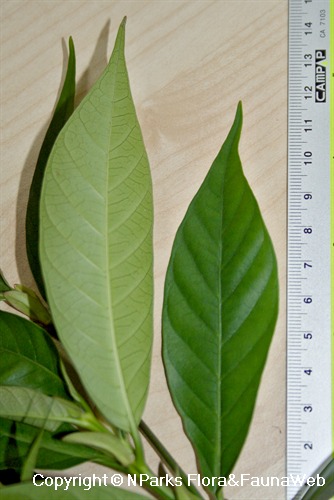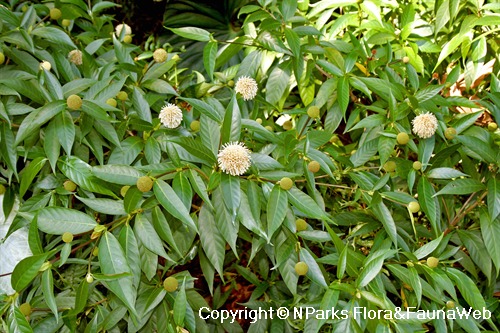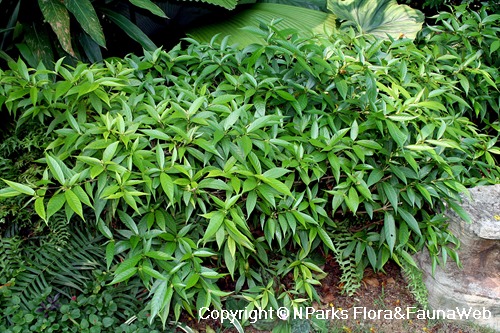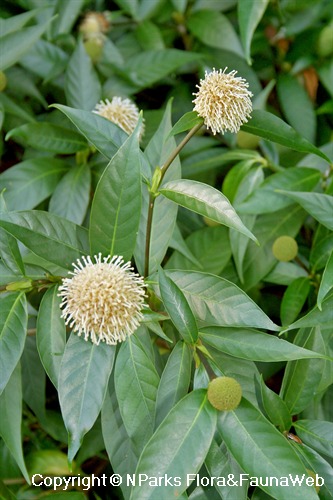
Back
Neonauclea pallida (Reinw. ex Havil.) Bakh.f. subsp. pallida
| Family Name: | Rubiaceae |
| Synonyms: | Nauclea sumatrana, Nauclea lanceolata var. longifolia |
Name
Classifications and Characteristics
| Plant Division | Angiosperms (Flowering Seed Plants) (Dicotyledon) |
|---|---|
| Plant Growth Form | Tree (Small (6m-15m), Shrubby (1m-5m)), Shrub |
| Lifespan (in Singapore) | Perennial |
| Mode of Nutrition | Autotrophic |
| Plant Shape | Shrubby |
| Maximum Height | 2 m to 7 m |
Biogeography
| Native Distribution | Andaman Islands, Myanmar, Indonesia (Sumatra, Java, Borneo) |
|---|---|
| Native Habitat | Terrestrial (Riverine) |
| Preferred Climate Zone | Tropical |
Description and Ethnobotany
| Growth Form | Woody rheophytic shrub or small tree, typically 7m tall (when grown as tree), sometimes reaching 10m height in the wild. Atypically non-myrmecophytic (having symbiotic relations with ants), unlike other Neonauclea species. |
|---|---|
| Foliage | Narrowly elliptical to lanceolate, 10-20cm long by 3-6cm wide, arranged in opposite pairs, with acuminate to cuspidate tips and cuneate bases, glabrous, medium green on adaxial (upper) surface, pale green on abaxial (lower) side, with 6-12 pairs of lateral veins. Terminal foliar-buds characteristically enclosed within a pair of ovate and strongly-flattened stipules. Young leaves glossy dark green, especially when viewed from underside. Petioles (leaf stalks) 1.0-2.5cm long, slightly winged. |
| Flowers | Small, whitish to pale yellowish-to-greenish white, each with 5 joined petals, numerous and densely crowded into globose inflorescence heads, ovaries closely-spaced but not fused. Inflorescences terminal, solitary, 2.5-4.0 cm acoss, lacking in interfloral bracteoles, with spiky appearance created by the style of many flowers (a stalk with a pollen-receiving tip). Young inflorescence heads green, resembling small spiky balls, enclosed within a pair of enlarged stipules modifled into conspicuous pubescent greenish (often tinged red) bracts that fall off quickly. Flowers primarily pollinated by pyralid moths, but also visited by various other moth, beetle and stingless bee species. Blooming appears to occur annually in Singapore, between the months of March and May. |
| Fruit | Individual fruitlets capsular, small (8-10mm long), topped by persistent basal calyx remnants, closely clustered into globose fruiting heads 2.0-2.5cm across, ripening to brown and splitting to disperse numerous seeds. Seeds tiny, ellipsoidal, slightly flattened on lateral end, shortly-winged on both sides. |
| Others - Plant Morphology | Bark: Greyish-brown to blackish-brown, smooth. Stipules: Prominent, ovate to elliptical, 15-25mm long by 6-10mm wide, pale green, keeled in the centre, pubescent at base, occuring on both sides of leaf petioles, transient and soon falling off, usually present on the 3 youngest nodes only. |
| Habitat | Riparian, occuring along rivers, streams and near waterfalls, usually growing at lowland alluvial and rocky sites exposed to seasonal innudation. |
| Similar | Resembles Neonauclea pallida (Hooded Bur-Flower) and Neonauclea pallida ssp. malaccensis, both of which are differentiated by the presence of bright green interfloral bracteoles in between their flowers. Also bears strong resemblance to various members from the Nauclea genus (eg. Nauclea subtida, whose ovaries are fused and whose 1cm-diameter inflorescences occur in heads of 2-3), Adina genus (eg. Adina pilulifera, which has branched inflorescence heads) and Cephalanthus genus -- of which Cephalanthus occidentalis (Common Buttonbush) is the most commonly used in temperate horticulture. |
| Cultivation | If grown as hedge, prune periodically to maintain size and form. Tolerates waterlogged soils and occasional flooding. Propagate by seeds and air-layering of stems. |
| Etymology | Genus epithet Neonauclea derived from Greek terms of 'neo' (new) and the genus Nauclea -- which in turn is derived from the Greek 'naus' (ship) and 'kleio' (to shut, confine), or alternatively from the Latin 'naucula' (a little ship) -- probably describing the boat-shaped halves of the plant's fruit capsules. 'New' in this case refers to taxonomic reclassifications in the Nauclea genus due to morphological and genetic reassessements. Species and subspecies epithet pallida means 'pale' or 'pallid', a reference to the colour of the inflorescences. |
| Ethnobotanical Uses | Food (Herb or Spice) Others: In Indonesia, leaves of species form are used externally to promote urination. Medicinal properties (if any) may also be present in this closely-related subspecies. |
Landscaping Features
| Desirable Plant Features | Ornamental Foliage, Ornamental Flowers |
|---|---|
| Landscape Uses | Riverine, Flowerbed / Border, Hedge / Screening |
| Thematic Landscaping | Naturalistic Garden |
Fauna, Pollination and Dispersal
| Pollination Method(s) | Biotic (Fauna) (Insects (Butterfly, Moth), Insects (Ant, Beetle, Fly, Thrip, Wasp)) |
|---|---|
| Seed or Spore Dispersal | Abiotic (Explosive Dehiscence) |
Plant Care and Propagation
| Light Preference | Full Sun |
|---|---|
| Water Preference | Moderate Water |
| Plant Growth Rate | Moderate |
| Rootzone Tolerance | Fertile Loamy Soils, Waterlogged Soils (Drains Site) |
| Maintenance Requirements | Moderate |
| Pruning | if grown as hedge, prune periodically to maintain size. |
| Propagation Method | Seed, Air-Layering |
Foliar
| Foliage Retention | Evergreen |
|---|---|
| Mature Foliage Colour(s) | Green |
| Mature Foliage Texture(s) | Smooth, Raised / Sunken Veins, Thin |
| Foliar Type | Simple / Unifoliate |
| Foliar Arrangement Along Stem | Opposite |
| Foliar Shape(s) | Non-Palm Foliage (Ovate, Elliptical) |
| Foliar Venation | Pinnate / Net |
| Foliar Margin | Entire |
| Foliar Apex - Tip | Cuspidate, Acuminate |
| Foliar Base | Cuneate |
| Typical Foliar Area | Notophyll ( 20.25cm2 - 45 cm2 ) |
| Prominent Young Flush Colour(s) Remarks | Glossy Dark Green |
Non - Foliar and Storage
| Trunk Type (Non Palm) | Woody |
|---|---|
| Bark Colour(s) | Greyish-brown to blackish-brown |
| Mature Bark Texture | Smooth |
| Stem Type & Modification | Woody |
| Root Type | Underground (Tap Root, Fibrous Root) |
Floral (Angiosperm)
| Flower & Plant Sexuality | Bisexual Flowers |
| Flower Colour(s) | Cream / Off-White, White |
|---|---|
| Flower Symmetry | Radial |
| Flower Size - Remarks | Inflorescence heads 25-40mm in diameter |
| Inflorescence Type | Head / Capitulum |
| Flowering Habit | Polycarpic |
| Flowering Period Remarks | Yearly, around April |
Fruit, Seed and Spore
| Mature Fruit Colour(s) | Brown |
|---|---|
| Fruit Classification | Aggregate Fruit (Syncarp) |
| Fruit Type | Dehiscent Dry Fruit , Capsule |
Image Repository
Others
| Master ID | 29441 |
|---|---|
| Species ID | 3750 |
| Flora Disclaimer | The information in this website has been compiled from reliable sources, such as reference works on medicinal plants. It is not a substitute for medical advice or treatment and NParks does not purport to provide any medical advice. Readers should always consult his/her physician before using or consuming a plant for medicinal purposes. |

